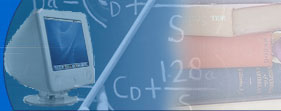A
ARTA PICTURE'S WORTH A THOUSAND WORDS:
http://www.readwritethink.org/lessons/lesson_view.asp?id=116
Artwork becomes the inspiration for brainstorming sessions,
where your students will collectively create a word and idea
bank based on a chosen image. They will then individually cre-
ate a narrative around the work of art, extending past the bor-
ders of the image to create a whole story. Think of creating
a class book to collect and publish your class stories, with
the art work as the cover and displaying your book at Open
House night.
BACK TO TOP
B
BACK TO TOP
C
CHECKLISTS
CORRECTING AND PROOFREADING CHECKLIST:
http://teachers.net/gazette/JUL03/images/proofreading.pdf
To help your fourth grade students get their
writing projects off to a good start this
year, print out several of these editing
checklists for each student. After proofing
their papers and checking off each item,
they can attach their checklist to their
writing assignments.
PEER EDITING CHECKLIST:
http://206.218.128.2/laintech/peer.htm
Sometimes students feel uncertain about
editing their peers' writing exercises. This
checklist will provide a solid guide to make
them feel more comfortable with the
procedure, while lending a rubric for their
own assignments as well.
CITATIONS
CITATION GENERATOR:
http://www.noodletools.com/noodlebib/citeone.php
Upper elementary students will learn how to
create MLA citations for books, online
sources, magazines, interviews, and
newspapers with this interactive citation
generator. Input the type of resource you
are using;a series of questions will guide
students with their input until they submit
it for the proper citation.
PRINTABLE BIBLIOGRAPHIC PLANNING SHEETS:
http://www.bcps.org/offices/lis/models/tips/i-search/bibplan.html
Help your students to correctly keep track
of sources used for research papers with
this printable bibliography sheet. Separate
sections allow for printed materials, for
articles rather than books, for interviews,
field trips, and more.
BACK TO TOP
D
BACK TO TOP
E
EXERCISES
WRITING EXERCISES:
http://www.everydayspelling.com/workout/prompts/promptsndx.html
Writing exercises here cover grades one through eight, as
well as all of the major writing formats. Grades 3 to 5
will write notes, directions, letters, announcements,
opinions, and more. Archived writing prompts are also
available.
BACK TO TOP
F
FAIRY TALE GENRE
ONCE UPON A TIME:
http://askeric.org/~rjlaundr/pgems/Writing_comp/WCP0025.html
This lesson plan for writing gives students the middle
of a relatively unknown fairy tale. Using the elements
of story and specifically of the fairy tale genre, stu-
dents will "work backwards" to recreate what came be-
fore the supplied text, and what came after.
BACK TO TOP
G
BACK TO TOP
H
BACK TO TOP
I
INSTRUCTIONAL STRATEGIES
INSTRUCTIONAL STRATEGIES FOR WRITING:
http://www.sasked.gov.sk.ca/docs/mla/write.html
Find several resources to build
instructional units for wri-ting assignments
for your middle and high school classes. The
writing process is explained, along with
assessments for the different developmental
stages of writing, pre-writing activities,
and strategies for considering format,
audience, and genre. Also find tips for peer
and teacher conferences, and checklists for
writing in progress.
BACK TO TOP
J
BACK TO TOP
K
BACK TO TOP
L
LETTER WRITING
DEAR CHARACTER:
http://www.col-ed.org/cur/lang/lang29.txt
Your students will write a letter from one character in a class novel to
another character--you may even wish to
consider allowing them to write letters between characters in different novels.
The purpose is still the same, to exhibit
understanding of character within the story
frame, and how he/she might act and respond in any given contextual situation.
LETTER WRITING UNIT:
http://volweb.utk.edu/Schools/bedford/harrisms/letterwrite.htm
Introduce this letter writing unit early in
the year to your fifth grade class. The unit
itself covers two weeks of instruction and
student work, reviewing and practicing both
friendly (informal) and business letter
writing formats. Included are student
samples, as well as rubrics.
BACK TO TOP
M
BACK TO TOP
N
BACK TO TOP
O
BACK TO TOP
P
PASS-AROUND PROCESS
I AM THE WORDS AND THE PICTURES I CREATE:
http://www.youthfirst.org/winners/pappas.htm
Using a pass-around process, fourth grade students will
be writing a paragraph about themselves or their neighborhood, revising their writing and then illustrating their
passages. They will then pass these illustrations over to
a fifth grade class, which must then write their own paragraphs about the illustrations. Class presentations will
compare the original to the later writings, with the illustrations as the prompts.
PROMPTS
WRITING PROMPTS:
http://www.everydayspelling.com/workout/prompts/promptsndx.html
Writing prompts are included in a wide variety of grade-appropriate formats, covering grades one through eight,
with guidelines for properly completing each exercise.
QUOTATION JOURNAL PROMPTS:
http://www.teachers.net/lessons/posts/1860.html
Let students discuss these journal topics in groups before
proceeding to the writing stage. Each prompt is a provocative quote; students can consider how it applies to their
own lives and experiences.
BACK TO TOP
Q
BACK TO TOP
R
BACK TO TOP
S
BACK TO TOP
T
BACK TO TOP
U
BACK TO TOP
V
BACK TO TOP
W
WORKSHEETS
BEGINNING WRITING WORKSHEETS:
http://www.abcteach.com/directory/basics/writing/early_childhood_writing_/
Numerous printable worksheets here support student attempts at both reading and writing, supplementing your
own language arts curriculum for the primary classroom.
WRITING PROCESS
THE ABC'S OF THE WRITING PROCESS:
https://www.angelfire.com/wi/writingprocess/
From prewriting to editing and through to publishing, This site offers various tips, strategies, and guides
for both teachers and students alike,
covering the complete writing process.
BACK TO TOP
X
BACK TO TOP
Y
BACK TO TOP
Z
|

